RENAULT SCENIC 2011 J95 / 3.G Engine And Peripherals EDC16 Workshop Manual
Manufacturer: RENAULT, Model Year: 2011, Model line: SCENIC, Model: RENAULT SCENIC 2011 J95 / 3.GPages: 365, PDF Size: 2.11 MB
Page 341 of 365

13B-341
MR-372-J84-13B200$900.mif
V13
EDC16
Program No.: C1
Vdiag no.: 18, 1C, 20,
50, 58, 5CDIESEL INJECTION
Fault finding – Tests13B
TEST 2 Turbocharger air chain
Check for the air filter
Check the replacement frequency for the air filter in the Maintenance Booklet.
Compare the part numbers of the air filter fitted to the vehicle and that of the air filter recommended by the
manufacturer.
Check the air filter direction of fitting.
Is the air filter fitted to the vehicle correct?
YES NO
Check the condition of the air filter
Visually inspect the condition of the filter section of
the air filter.
Is either the air filter or its seal damaged?
Is the air filter clogged (does it contain a lot of
impurities)?
NO
Low pressure circuit check
Note:
According to the vehicle type, maximum visual
access will either be from above or from below.
Visually inspect the condition of the following
components:
– fresh air inlet scoop on the front end panel of the
vehicle,
– air filter air inlet pipe,
– filter air pipe up to the compressor inlet,
– air flowmeter mountings.
Is one of these components incorrect
(disconnected, cut, bent, pierced or kinked
pipes)?
NO
YESReplace the air filter (see MR 364
(Mégane II), 370 (Scénic II) or 395
(Laguna II), Mechanical, 12A, Fuel
mixture, Air filter, Removal –
Refitting).
YESReplace the defective parts (see MR 364
(Mégane II), 370 (Scénic II) or 395
(Laguna II), Mechanical, 12B,
Turbocharging).
EDC16_V50_TEST2/EDC16_V58_TEST2/EDC16_V5C_TEST2/EDC16_V18_TEST2/EDC16_V1C_TEST2/EDC16_V20_TEST2
Page 342 of 365
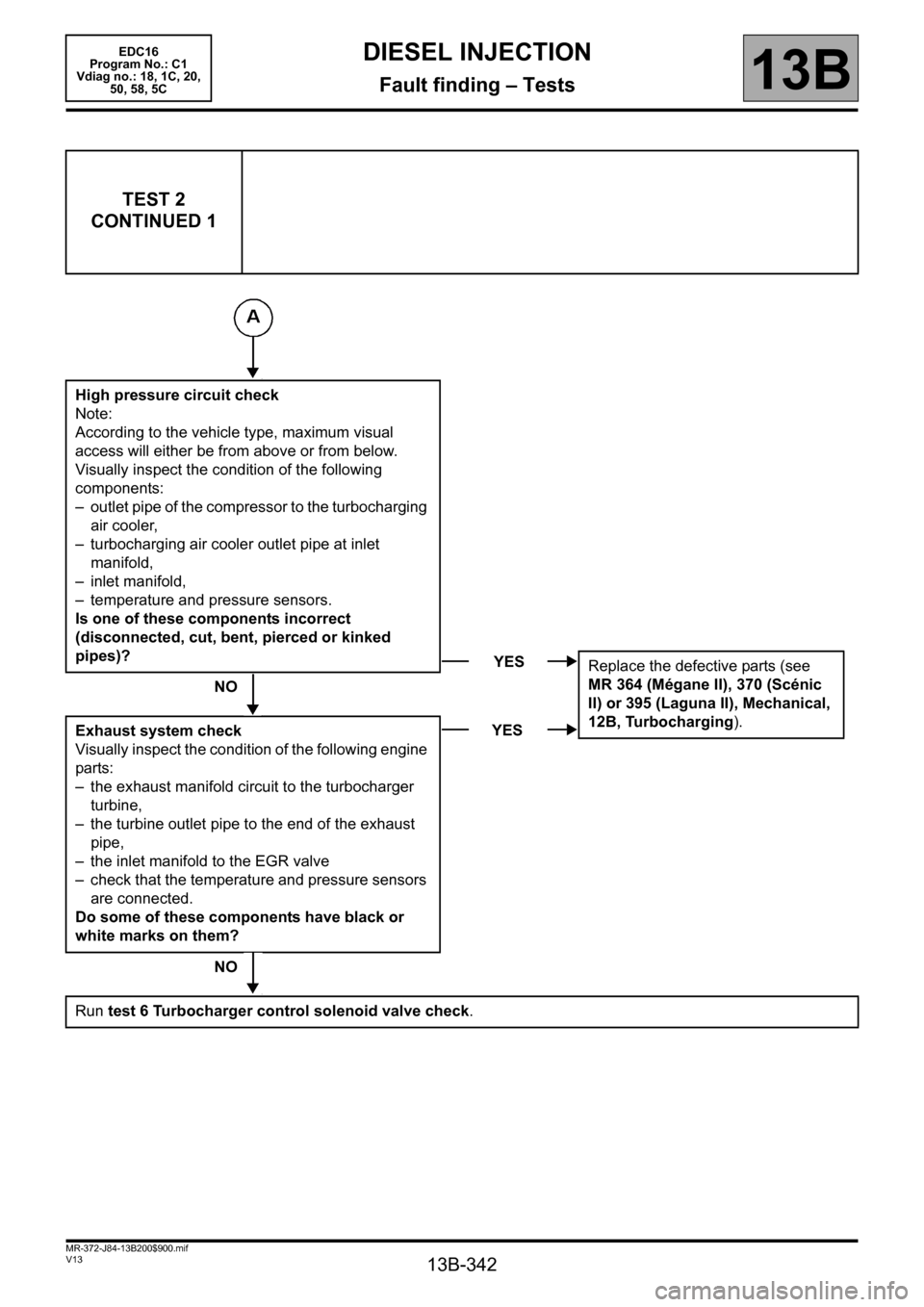
13B-342
MR-372-J84-13B200$900.mif
V13
EDC16
Program No.: C1
Vdiag no.: 18, 1C, 20,
50, 58, 5CDIESEL INJECTION
Fault finding – Tests13B
TEST 2
CONTINUED 1
High pressure circuit check
Note:
According to the vehicle type, maximum visual
access will either be from above or from below.
Visually inspect the condition of the following
components:
– outlet pipe of the compressor to the turbocharging
air cooler,
– turbocharging air cooler outlet pipe at inlet
manifold,
– inlet manifold,
– temperature and pressure sensors.
Is one of these components incorrect
(disconnected, cut, bent, pierced or kinked
pipes)?
NO
Exhaust system check
Visually inspect the condition of the following engine
parts:
– the exhaust manifold circuit to the turbocharger
turbine,
– the turbine outlet pipe to the end of the exhaust
pipe,
– the inlet manifold to the EGR valve
– check that the temperature and pressure sensors
are connected.
Do some of these components have black or
white marks on them?
NO
Run test 6 Turbocharger control solenoid valve check.
YES
Replace the defective parts (see
MR 364 (Mégane II), 370 (Scénic
II) or 395 (Laguna II), Mechanical,
12B, Turbocharging).
YES
Page 343 of 365
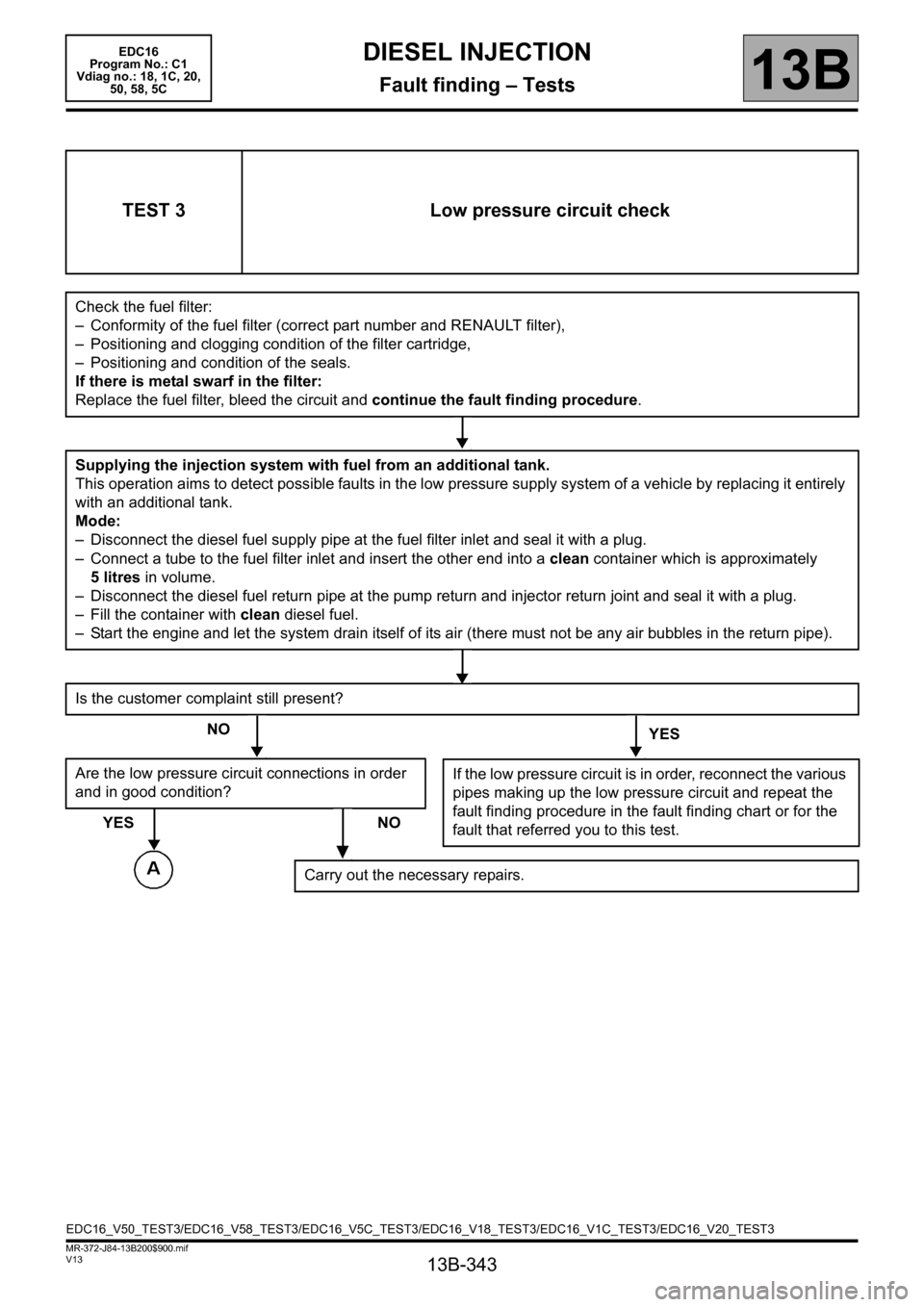
13B-343
MR-372-J84-13B200$900.mif
V13
EDC16
Program No.: C1
Vdiag no.: 18, 1C, 20,
50, 58, 5CDIESEL INJECTION
Fault finding – Tests13B
TEST 3 Low pressure circuit check
Check the fuel filter:
– Conformity of the fuel filter (correct part number and RENAULT filter),
– Positioning and clogging condition of the filter cartridge,
– Positioning and condition of the seals.
If there is metal swarf in the filter:
Replace the fuel filter, bleed the circuit and continue the fault finding procedure.
Supplying the injection system with fuel from an additional tank.
This operation aims to detect possible faults in the low pressure supply system of a vehicle by replacing it entirely
with an additional tank.
Mode:
– Disconnect the diesel fuel supply pipe at the fuel filter inlet and seal it with a plug.
– Connect a tube to the fuel filter inlet and insert the other end into a clean container which is approximately
5 litres in volume.
– Disconnect the diesel fuel return pipe at the pump return and injector return joint and seal it with a plug.
– Fill the container with clean diesel fuel.
– Start the engine and let the system drain itself of its air (there must not be any air bubbles in the return pipe).
Is the customer complaint still present?
NO
YES
Are the low pressure circuit connections in order
and in good condition?
YES NO
If the low pressure circuit is in order, reconnect the various
pipes making up the low pressure circuit and repeat the
fault finding procedure in the fault finding chart or for the
fault that referred you to this test.
Carry out the necessary repairs.
EDC16_V50_TEST3/EDC16_V58_TEST3/EDC16_V5C_TEST3/EDC16_V18_TEST3/EDC16_V1C_TEST3/EDC16_V20_TEST3
Page 344 of 365
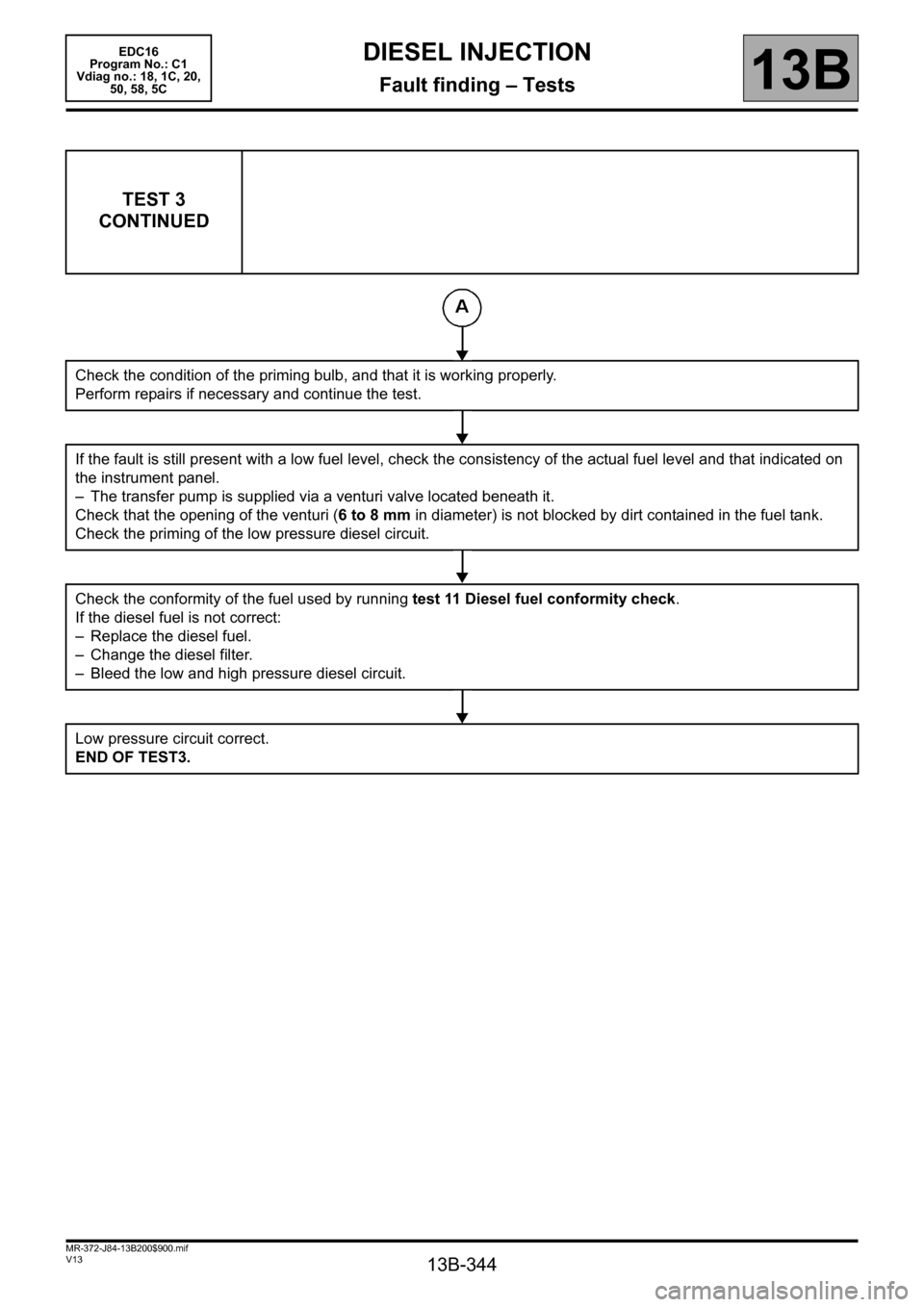
13B-344
MR-372-J84-13B200$900.mif
V13
DIESEL INJECTION
Fault finding – Tests
EDC16
Program No.: C1
Vdiag no.: 18, 1C, 20,
50, 58, 5C
13B
TEST 3
CONTINUED
Check the condition of the priming bulb, and that it is working properly.
Perform repairs if necessary and continue the test.
If the fault is still present with a low fuel level, check the consistency of the actual fuel level and that indicated on
the instrument panel.
– The transfer pump is supplied via a venturi valve located beneath it.
Check that the opening of the venturi (6 to 8 mm in diameter) is not blocked by dirt contained in the fuel tank.
Check the priming of the low pressure diesel circuit.
Check the conformity of the fuel used by running test 11 Diesel fuel conformity check.
If the diesel fuel is not correct:
– Replace the diesel fuel.
– Change the diesel filter.
– Bleed the low and high pressure diesel circuit.
Low pressure circuit correct.
END OF TEST3.
Page 345 of 365
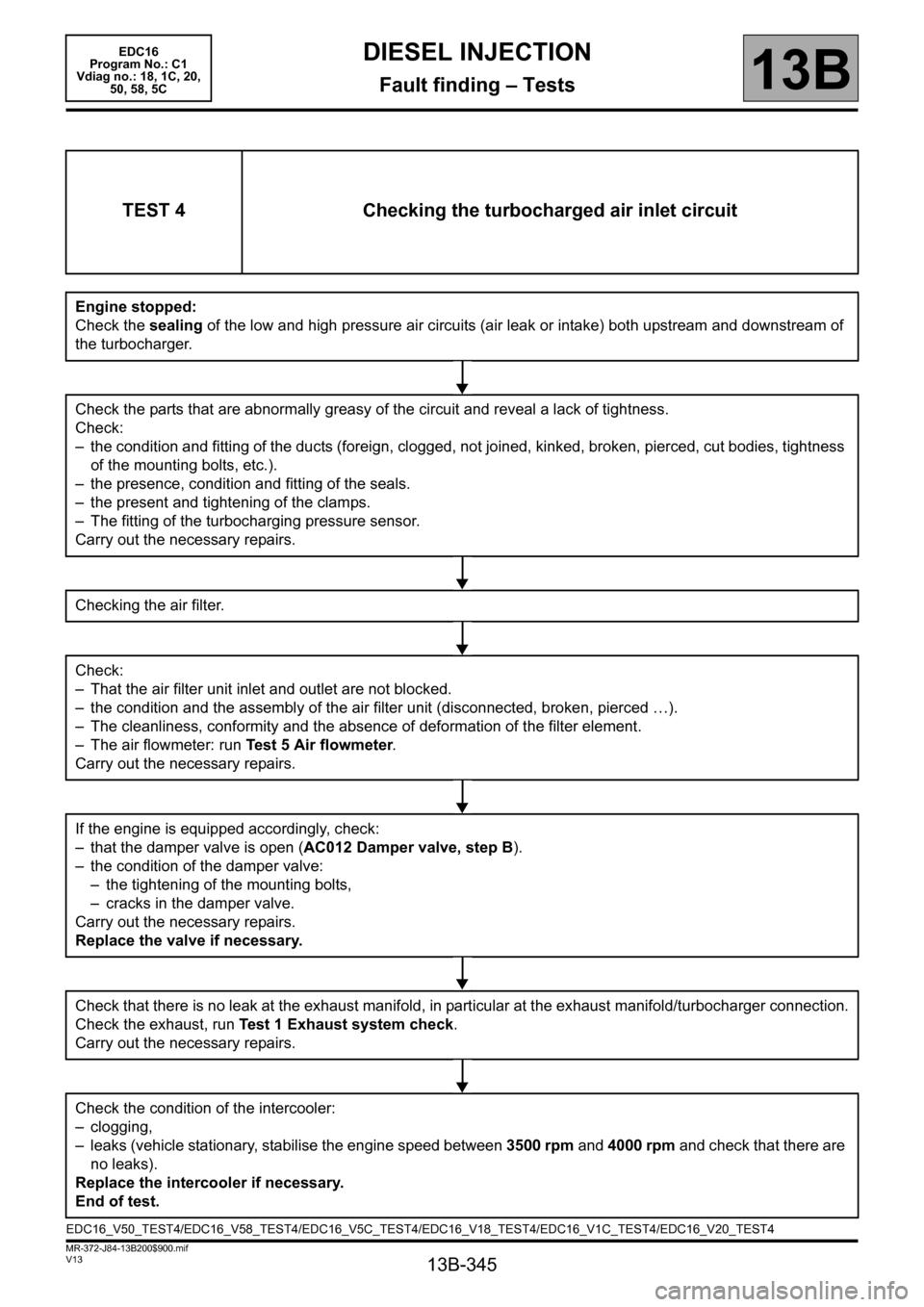
13B-345
MR-372-J84-13B200$900.mif
V13
DIESEL INJECTION
Fault finding – Tests
EDC16
Program No.: C1
Vdiag no.: 18, 1C, 20,
50, 58, 5C
13B
TEST 4 Checking the turbocharged air inlet circuit
Engine stopped:
Check the sealing of the low and high pressure air circuits (air leak or intake) both upstream and downstream of
the turbocharger.
Check the parts that are abnormally greasy of the circuit and reveal a lack of tightness.
Check:
– the condition and fitting of the ducts (foreign, clogged, not joined, kinked, broken, pierced, cut bodies, tightness
of the mounting bolts, etc.).
– the presence, condition and fitting of the seals.
– the present and tightening of the clamps.
– The fitting of the turbocharging pressure sensor.
Carry out the necessary repairs.
Checking the air filter.
Check:
– That the air filter unit inlet and outlet are not blocked.
– the condition and the assembly of the air filter unit (disconnected, broken, pierced …).
– The cleanliness, conformity and the absence of deformation of the filter element.
– The air flowmeter: run Test 5 Air flowmeter.
Carry out the necessary repairs.
If the engine is equipped accordingly, check:
– that the damper valve is open (AC012 Damper valve, step B).
– the condition of the damper valve:
– the tightening of the mounting bolts,
– cracks in the damper valve.
Carry out the necessary repairs.
Replace the valve if necessary.
Check that there is no leak at the exhaust manifold, in particular at the exhaust manifold/turbocharger connection.
Check the exhaust, run Test 1 Exhaust system check.
Carry out the necessary repairs.
Check the condition of the intercooler:
– clogging,
– leaks (vehicle stationary, stabilise the engine speed between 3500 rpm and 4000 rpm and check that there are
no leaks).
Replace the intercooler if necessary.
End of test.
EDC16_V50_TEST4/EDC16_V58_TEST4/EDC16_V5C_TEST4/EDC16_V18_TEST4/EDC16_V1C_TEST4/EDC16_V20_TEST4
Page 346 of 365

13B-346
MR-372-J84-13B200$900.mif
V13
DIESEL INJECTION
Fault finding – Tests
EDC16
Program No.: C1
Vdiag no.: 18, 1C, 20,
50, 58, 5C
13B
* OCR: Opening Cyclic Ratio
TEST 5 Air flowmeter
Impurities in the grilles:
Visual inspection: remove the flowmeter. There should be no foreign bodies on the grilles (see diagram 110734).
Do not clean the grilles using compressed air or any other procedure: this damages the sensors and
creates variations from the values displayed on the CLIP tool.
Check the sealing of the air circuit upstream of the air flowmeter:
disconnected or pierced pipes and air filter unit, seals present.
Replace the air flowmeter if necessary and clean upstream of this, if necessary.
Damage to electrical components:
Visual inspection:
– remove the flowmeter, the components should not be broken (see diagram no. 110736).
Replace the air flowmeter if necessary.
Oxidation of the electrical components:
Visual inspection:
– remove the air flowmeter, there must not be any green deposits on the electrical components.
Replace the air flowmeter if necessary.
Clogging of the air flowmeter:
Te s t :
– Check the values for conformity:
* During the first 5 seconds after starting:
– Coolant temperature: 80°C.
– Engine speed: at idle speed (750 rpm < PR055 < 850 rpm).
– Air flow measurement: 37 kg/h < PR132 < 57 kg/h.
– EGR valve OCR*: between - 10% and 0%.
* After the starting phase:
– Coolant temperature: 80°C,
– Engine speed: at idle speed (750 rpm < PR055 < 850 rpm).
– Air flow measurement: 25 kg/h < PR132 < 35 kg/h.
– EGR valve OCR*: between 10% and 40%.
– Refer to the interpretation of DF056 Air flow sensor circuit 2.DEF, for the air flowmeter checks.
Replace the air flowmeter if necessary.
EDC16_V50_TEST5/EDC16_V58_TEST5/EDC16_V5C_TEST5/EDC16_V18_TEST5/EDC16_V1C_TEST5/EDC16_V20_TEST5
Page 347 of 365
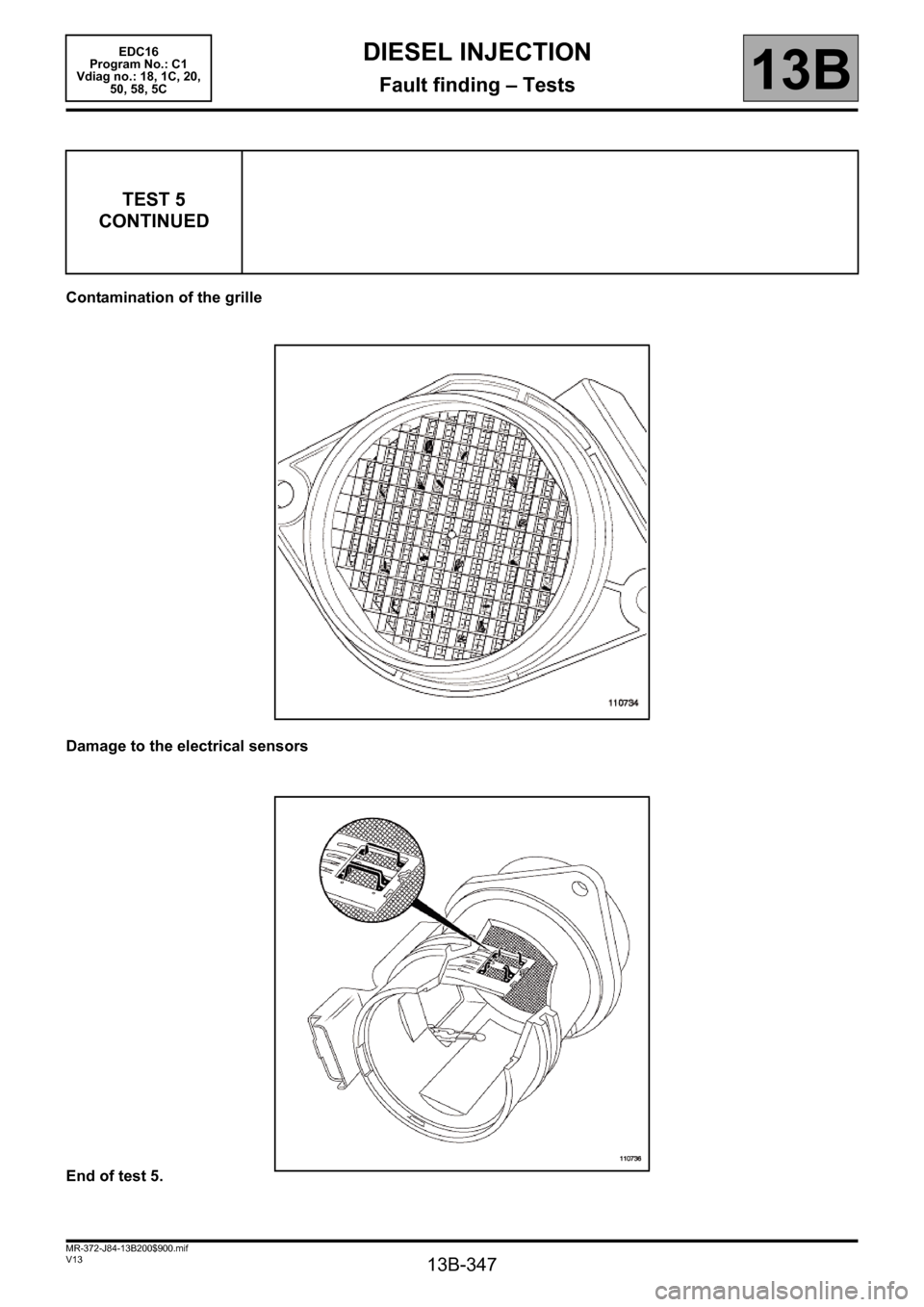
13B-347
MR-372-J84-13B200$900.mif
V13
DIESEL INJECTION
Fault finding – Tests
EDC16
Program No.: C1
Vdiag no.: 18, 1C, 20,
50, 58, 5C
13B
Contamination of the grille
Damage to the electrical sensors
End of test 5.
TEST 5
CONTINUED
Page 348 of 365
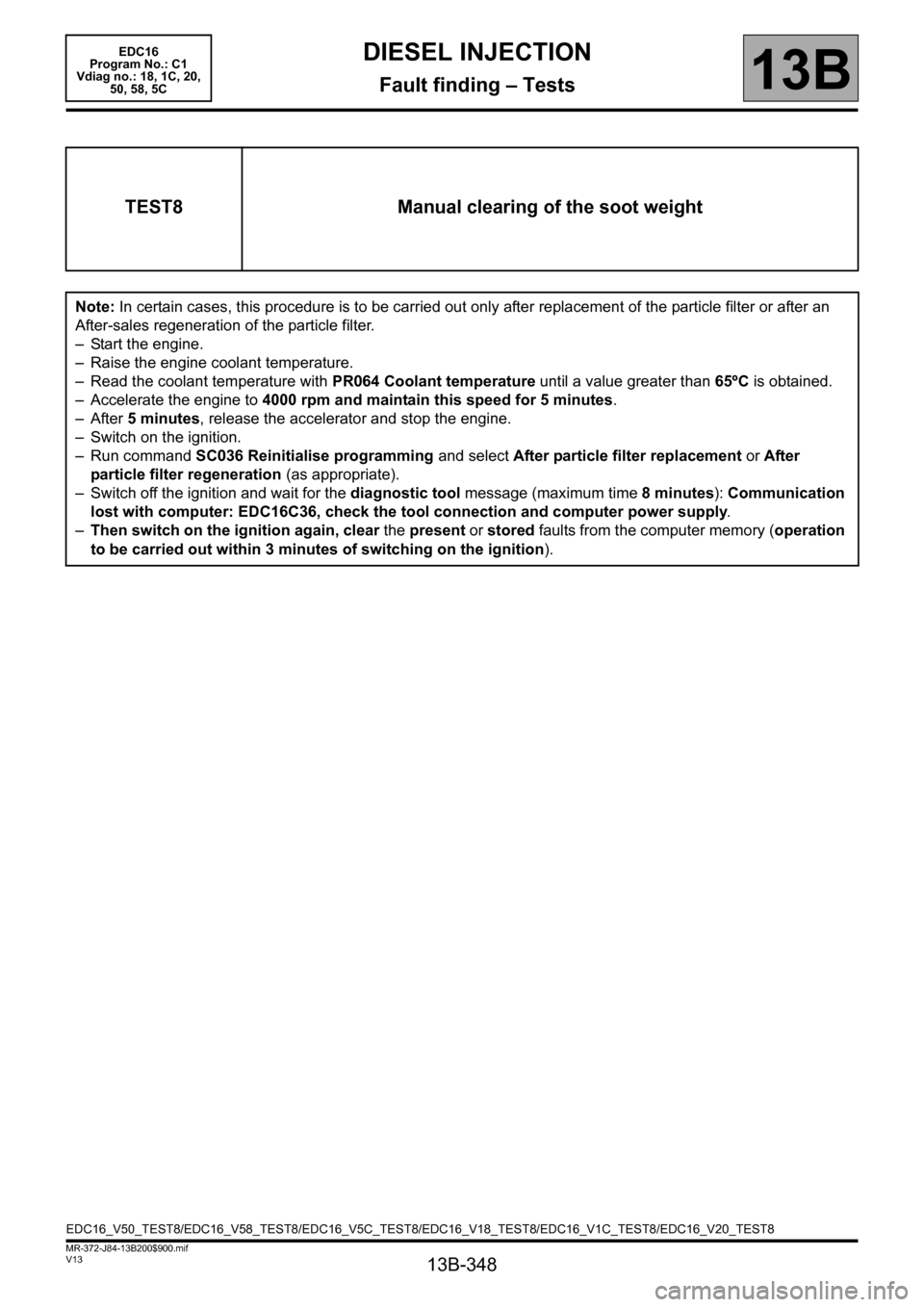
13B-348
MR-372-J84-13B200$900.mif
V13
EDC16
Program No.: C1
Vdiag no.: 18, 1C, 20,
50, 58, 5CDIESEL INJECTION
Fault finding – Tests13B
TEST8 Manual clearing of the soot weight
Note: In certain cases, this procedure is to be carried out only after replacement of the particle filter or after an
After-sales regeneration of the particle filter.
– Start the engine.
– Raise the engine coolant temperature.
– Read the coolant temperature with PR064 Coolant temperature until a value greater than 65ºC is obtained.
– Accelerate the engine to 4000 rpm and maintain this speed for 5 minutes.
–After 5 minutes, release the accelerator and stop the engine.
– Switch on the ignition.
– Run command SC036 Reinitialise programming and select After particle filter replacement or After
particle filter regeneration (as appropriate).
– Switch off the ignition and wait for the diagnostic tool message (maximum time 8 minutes): Communication
lost with computer: EDC16C36, check the tool connection and computer power supply.
–Then switch on the ignition again, clear the present or stored faults from the computer memory (operation
to be carried out within 3 minutes of switching on the ignition).
EDC16_V50_TEST8/EDC16_V58_TEST8/EDC16_V5C_TEST8/EDC16_V18_TEST8/EDC16_V1C_TEST8/EDC16_V20_TEST8
Page 349 of 365

13B-349
MR-372-J84-13B200$936.mif
V13
13B
DIESEL INJECTION
Fault finding – Tests
Deformed, twisted blade ("soft" foreign body)
Broken blades ("hard" foreign body)
TEST 7
CONTINUED 4
EDC16
Program No: C1
Vdiag No: 18, 1C, 20,
50, 58, 5C
MR-372-J84-13B200$936.mif
Page 350 of 365
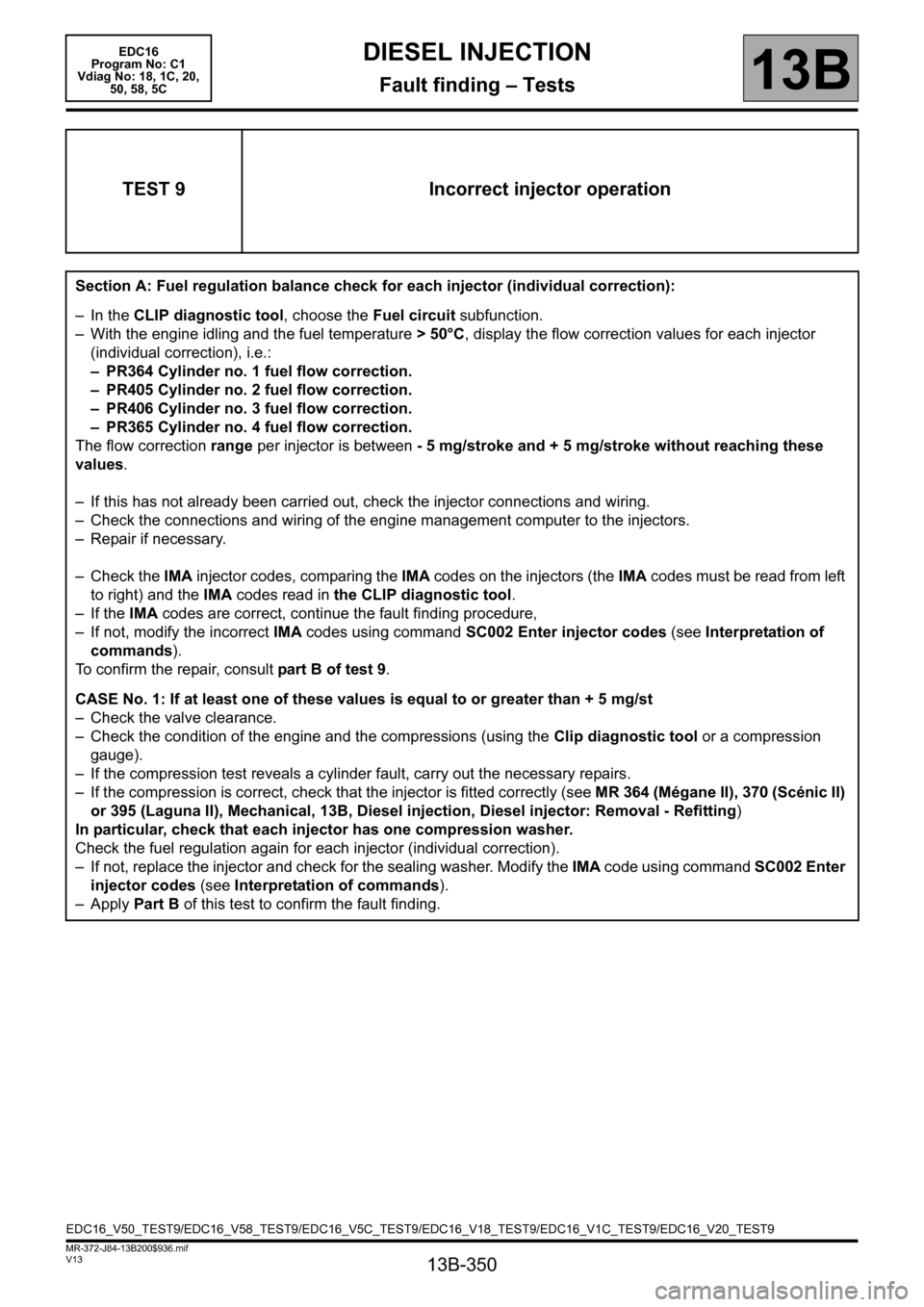
13B-350
MR-372-J84-13B200$936.mif
V13
DIESEL INJECTION
Fault finding – Tests
EDC16
Program No: C1
Vdiag No: 18, 1C, 20,
50, 58, 5C
13B
TEST 9 Incorrect injector operation
Section A: Fuel regulation balance check for each injector (individual correction):
– In the CLIP diagnostic tool, choose the Fuel circuit subfunction.
– With the engine idling and the fuel temperature > 50°C, display the flow correction values for each injector
(individual correction), i.e.:
– PR364 Cylinder no. 1 fuel flow correction.
– PR405 Cylinder no. 2 fuel flow correction.
– PR406 Cylinder no. 3 fuel flow correction.
– PR365 Cylinder no. 4 fuel flow correction.
The flow correction range per injector is between - 5 mg/stroke and + 5 mg/stroke without reaching these
values.
– If this has not already been carried out, check the injector connections and wiring.
– Check the connections and wiring of the engine management computer to the injectors.
– Repair if necessary.
– Check the IMA injector codes, comparing the IMA codes on the injectors (the IMA codes must be read from left
to right) and the IMA codes read in the CLIP diagnostic tool.
– If the IMA codes are correct, continue the fault finding procedure,
– If not, modify the incorrect IMA codes using command SC002 Enter injector codes (see Interpretation of
commands).
To confirm the repair, consult part B of test 9.
CASE No. 1: If at least one of these values is equal to or greater than + 5 mg/st
– Check the valve clearance.
– Check the condition of the engine and the compressions (using the Clip diagnostic tool or a compression
gauge).
– If the compression test reveals a cylinder fault, carry out the necessary repairs.
– If the compression is correct, check that the injector is fitted correctly (see MR 364 (Mégane II), 370 (Scénic II)
or 395 (Laguna II), Mechanical, 13B, Diesel injection, Diesel injector: Removal - Refitting)
In particular, check that each injector has one compression washer.
Check the fuel regulation again for each injector (individual correction).
– If not, replace the injector and check for the sealing washer. Modify the IMA code using command SC002 Enter
injector codes (see Interpretation of commands).
–Apply Part B of this test to confirm the fault finding.
EDC16_V50_TEST9/EDC16_V58_TEST9/EDC16_V5C_TEST9/EDC16_V18_TEST9/EDC16_V1C_TEST9/EDC16_V20_TEST9